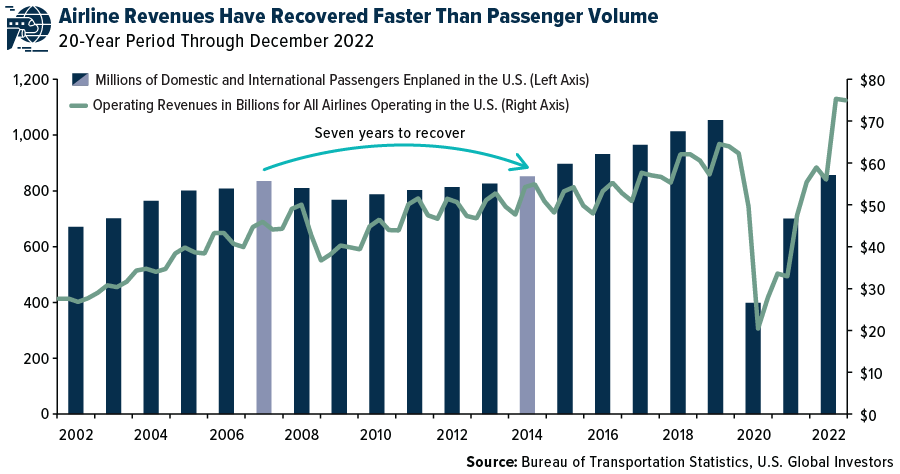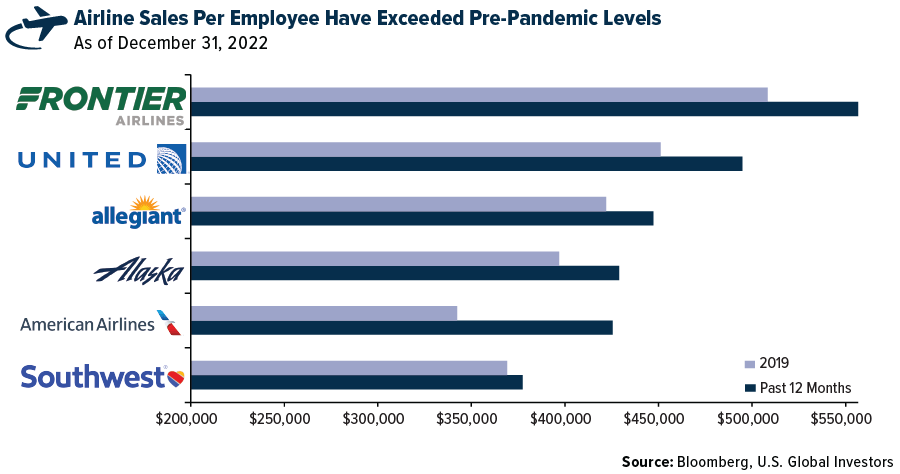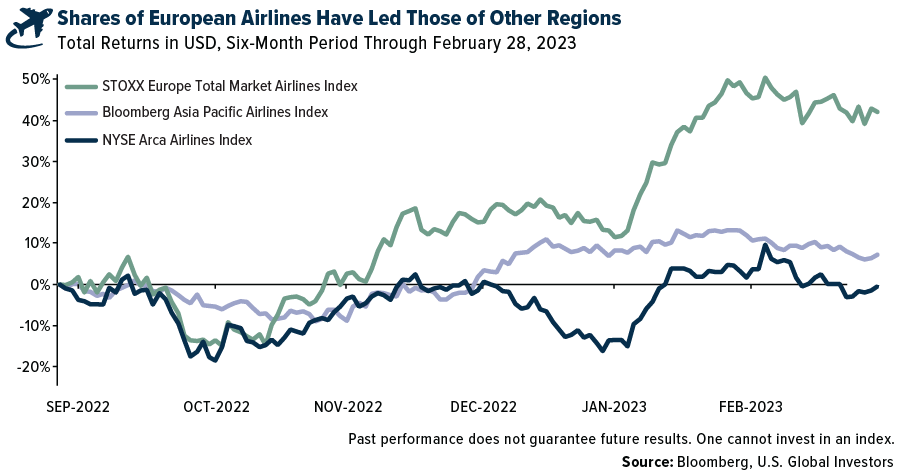“Lufthansa is back.”
Those are the enthusiastic opening remarks of Carsten Spohr, CEO of Deutsche Lufthansa, in the European airline’s earnings report for 2022, released last Friday.
I think it would be just as accurate to say that commercial aviation in general is back, with attractive investment opportunities.
Spohr reported that Lufthansa, Europe’s largest carrier group by revenue, achieved an “unprecedented turnaround” in 2022 on the back of increasing demand for air travel. Revenue of USD$34.5 billion was almost double what it collected in 2021, while free cash flow came in at $2.6 billion, the highest annual amount in the German company’s history. Shares were up approximately 5.3% in intraday trading on the news.

Lufthansa went on to announce that it ordered 22 new long-haul aircraft from Airbus and Boeing, the company’s largest order since 2013.
As I’ve said before, as an investor, I like to see when a company invests in itself. It tells me that management is optimistic about the future and is positioning the company for growth.
That’s exactly what airlines are doing around the globe right now. According to Airlines for America (A4A), U.S. carriers are investing a record amount in new aircraft, equipment, information technology and more. Capital expenditures are forecast to hit $27.0 billion this year, which would be significantly higher than the $21.2 billion airlines are estimated to have spent in 2022.
More Bang For The Buck
Lufthansa’s blockbuster report is just the latest signal that commercial aviation, one of the hardest-hit industries during the pandemic, may be ready to make a landing again in investors’ portfolios.
Travel demand is surging as Europe, China and other key markets have dropped travel restrictions, and in the interim, carriers have adapted by streamlining operations, eliminating unprofitable routes and more.
The actions appear to be working. Even though total passenger volume hasn’t fully recovered to pre-pandemic levels, operating revenues are soaring to new record highs, according to Bureau of Transportation Statistics (BTS) data.

Domestic airlines have managed this without having to cut jobs at the same pace as the tech industry. In fact, passenger airlines in the U.S. currently have the largest workforce in 20 years, according to A4A.
Staff members are also producing more bang for their buck. In the chart below, you can see that sales-per-employee for select carriers were higher in the past 12 months than in 2019, before the pandemic. This indicates that the decision not to sacrifice customer service in the name of cost-cutting has been financially rewarding for airlines.

To me, that’s a win-win-win-win: a win for airlines, win for employees, win for customers and a win for investors.
“Aviation Is Investible Again”
“Aviation is investible again,” says Jun Bei Liu, a portfolio manager at Sydney, Australia-based advisory firm Tribeca Investment Partners. Speaking to Bloomberg last month, Jun Bei said she believes Asian airlines “are going to go through the roof.”
I’ve highlighted Asian airlines in recent weeks, particularly after the Chinese government announced it was lifting pandemic-era quarantine requirements for travelers entering the country. I still agree with Jun Bei and others in forecasting a dramatic travel rebound in Asia this year, even though Chinese demand so far hasn’t been as strong as unexpected.
Perhaps surprisingly, shares of European carriers are leading those in Asia and the U.S. I say “surprisingly” because there are so many negative headlines about airlines right now, but often these headlines don’t accurately reflect what’s really happening. European airlines rose over 41% in the six months through the end of February, compared to Asian airlines, up 7%, and U.S. airlines, down slightly at negative 1%, over the same period.

Record-High Premiums On American Eagle Silver Coins
Switching gears, I want to briefly address something that came to my attention in the past couple of days. Kitco News’ Neils Christensen wrote a thought-provoking piece on American Eagle silver coins, sales of which slumped last year compared to sales in 2021. The U.S. Mint sold less than 16 million one-ounce silver coins in 2022, or 43.5% less than it did in the previous year.
As Neil points out, this decrease can’t be due to a lack of investor demand since silver bullion sales were solid elsewhere around the world in 2022. Australia’s Perth Mint, for instance, sold a record number of ounces.
Instead, the sales slump can be attributed to the 70% premium for the American Eagle coins. According to Neil, that’s a record-high premium. At today’s prices, then, a one-ounce American Eagle coin that contains $21 worth of silver is really priced at $35.
Neil explains why this is happening. To make its coins, the U.S. Mint buys silver “blanks” from private mints, and supply can be limited. Some people have suggested that the Mint should make its own silver blanks.
I’ll go a step further and suggest that precious metal miners should get in on this business. Imagine if they began pressing blanks and selling them to the U.S. Mint at a 70% premium. Would their share prices go up 70% as a result? I can’t say, but what I do know is that producers, particularly the juniors, are extremely undervalued right now.
Related: Central Bank Digital Currencies Are off to a Rough Start


